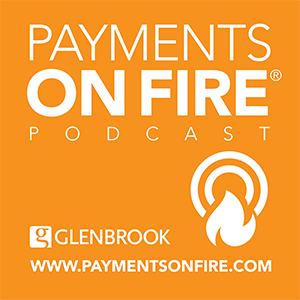With the EMV liability shift only days away, consumers and merchants are facing any number of changes in the point of sale experience. Unlike some other countries where the EMV change-over took place on a single day, the US EMV transition is going to be a long one, too. Not every issue is ironed out either. Join Glenbrook’s George Peabody and Philip Andreae, VP, Field Marketing North America at Oberthur Technologies in a discussion about EMV and debit, EMV transaction speed, and prospects for contactless, dual interface cards in the US.
Transcript below the player.
Payments on Fire 27
George: Welcome everyone to another Payments on Fire podcast. I’m George Peabody and today we’re going to talk a little more about EMV, since we’re only a couple of weeks away from the US liability shift. I’m fortunate to have Philip Andreae, who’s the VP for Field Marketing for North America at Oberthur Technologies. Philip’s got a lot of experience in his prior lives as well as with Oberthur regarding EMV, so Philip, welcome. Glad to have you here.
Philip: It’s nice to be with you, George. How are you today?
George: I’m doing great and I’m looking forward to this conversation, because we’re two weeks away. We’ve occasionally been talking about EMV here on this podcast series, and one of the last conversations I had was with Mike English at Heartland, and he pointed out some of the advantages of how EMV has been deployed, at least with the chip and signature with restaurant customers that he supports and also talked about some of the downsides, that it’s going to take 2-5 more seconds for these transactions to take place, and that there’s going to be some learning curve, not only for consumers and retailers, but also for the ISV community that will support this stuff. One of the topics that Mike and I didn’t get into, and I’d love to have that conversation with you today, is to talk about EMV with respect to debit here in the US, and debit routing. We both know that the Durbin Amendment, the EMV specification never anticipated the Durbin Amendment. Go figure, it was years and years beforehand. We have a technical approach in place using this common AID, but from your point of view, how’s that working and how do you see debit support coming along?
Philip: It’s an interesting conversation, this whole debit approach, and it’s one that takes many of us late into the night to figure out what’s going on, when’s it going to happen, who’s doing what, what will various organizations do. You bring Senator Durbin into the conversation and yes, it’s always fun to vilify him, but I think we need to back up a second and look at the reality, that here in the US market we have had and continue to have a unique competitive environment, where instead of having one network associated with a card associated with a bank account, we have multiple networks associated with a bank account on a card.
George: So, that simple environment that you just talked about, I would look north of the border and pick on Interac as a great example.
Philip: Exactly. If you look at the Canadian market, there is a single debit network called Interac, owned by all of the banks. Here in the United States, we’ve got sixteen, some people will argue eighteen, debit networks that are in some cases still owned by the banks, but in other cases, established as business with profit and loss statements and shareholders and everything else that goes with a competitive environment. Those entities basically saw the Durbin Amendment as a way to assure their survival in a competitive market. When we look inside EMV, what it did, what it created was this concept called the application identifier, the profile that was associated with a bank account, and it linked that profile as a dematerialization of the logo, the brand, that’s on the face of the card. Then defined a process called application selection, which allowed the terminal to look at the brands it accepted – Visa, MasterCard, Amex, Discover, etc. – and the brands that the card recognized, which are the same – Visa, MasterCard, Discover, American Express, etc., and then to offer whatever the max was between the applications, the brands on the card, and the applications the brands recognized contracted for by the terminal. When you have multiple brands associated with one bank account, you would then have to offer to the consumer all of those brands, and then let them select which brand, and therefore, you could have a consumer seeing Visa, seeing Shazam, seeing AFN, seeing NYCE, seeing Pulse, seeing Star, and you and I, as payments people, probably know a lot about all of those organizations, but when we ask our wives, when we ask our friends, there’s only one of those brands that they recognize. Durbin went and codified that competitive environment into law and basically said “like you’ve been doing in the past, you shall have (instead of could have), two unaffiliated networks associated with a card and account”. We are able to blame a Congressman, which we always love to do, for something we have actually created in our marketplace. Then the problem becomes, well great, we’ve got this Durbin Amendment, we’ve got this debit situation, we have this concept called signature debit (to classically push the credit button on the terminal), and PIN debit (classically push the debit button on the terminal), that was the way the merchants historically selected how to process that transaction. How do you do that in an EMV environment was the challenge that the US industry was faced with. Classically in a European or Asian market, if it’s a debit account, it has one cardholder verification message, typically PIN. In the United States, it could have many, and they could have many routes, unlike Canada, where there’s Interac, and that’s the way it is. So, we had to figure it out, and that was a struggle. It took a long time, the fact that while all of the thinking and the talking and the collaboration and the negotiation was taking place to figure out how to do it, we also had the courts coming into the conversation saying “we don’t agree with what the Federal Reserve wrote as the regulation” and somebody else coming in and saying “but the Court of Appeals believes that the Federal Reserve did it right” and the legal processes take a long time, so there was this noise in the market that said “how’s it all going to settle and can we figure out a technical solution?”.
George: Well, we’ve had that technical solution for some time, haven’t we? With the common AID to support the independent EFT networks.
Philip: Yeah, well we absolutely created and established a framework, and the keyword here is it’s a framework, not a specification. It is not a recommendation. It offers alternatives, and now you’ve got to turn around to the merchant community and say “Ok, we give you options, we give you thoughts, we give you a framework, go figure out how to implement.” Now the merchants sit there and go “Wait a second, I want to be a PIN steering merchant.” Therefore, one approach, which means they will select the common AID. Another merchant says “I love Visa”, so another approach, they will select the Visa AID. A third merchant says “I like that credit and debit button, let me allow those to persist” – a third approach. The final approach is, “I don’t want to do anything, why don’t I just do it the way EMV would have done it, so I’m going to offer Visa and the common AID to the consumer and let them choose.”
George: I don’t think we’ll see a lot of your fourth option there, but the other three that are under merchant control, I expect those things to happen.
Philip: Funny enough, George, I would have totally agreed with you that number four wouldn’t be a norm, but when we’ve done some testing, we’re actually finding that that is one of the choices that is being made. In fact, we had some cars at a particularly large bank at an ATM that did exactly that. From the consumer perspective, the original dream of EMV was a consistent experience. From a US perspective, there will be an experience as defined by the merchant and their partners. That’s where we are right now.
George: What’s your sense, Philip, with regard to debit issuance at this point? I just saw some numbers that came out this week that suggested we’d see the 25% of the debit cards out there by the end of the year should be chip cards, EMV cards; it is the decision making about getting ready to deploy all over the road with respect to the issuers. Are you seeing any themes?
Philip: The key thing is apprehension. We’ve absolutely seen apprehension on the part of the issuer, who wants to know what the experience will be before launching into the deployment of EMV cards.
George: That’s got to be pretty difficult if the merchant is making the choice whether to steer in a particular direction or not, right?
Philip: Yeah, exactly. And until they deploy, you don’t know that Walmart is taking approach A and Target took approach B, and the mom and pop down the street took approach c, and be able to experience what that consumer experience will be. So you kind of go “I’m uncomfortable, I’m not sure if my card will work right. I’d like to wait and see.” So you have people buying cards and putting them in their vaults waiting for some degree of comfort as to what the experience will be. There are two numbers out in market right now, there is the 40% projection that came out of iPay earlier this year, and there is the 25% forecast or sample that came out of Pulse this week. Are we going to get one or the other of those numbers? I’m not sure. We won’t go over 40%, we might get over 25%; I think we’ll be somewhere in between.
George: I wrote recently that it’s going to be interesting watching how many of the major retailers who have long since had the hardware in place, actually turn it on in October, or will they just wait until Q1 and let the holidays go by, and frankly, let someone else do the education on how to use a chip card with the consumer. Any predictions on your side about that?
Philip: The only prediction I have is personal experience and personal dialogue. We all know that Walmart has been EMV enabled for quite a while now. We know that Target is EMV enabled right now. We know that Home Depot is in deployment right now, so they are rolling stores out, and when I was speaking to one of my colleagues at Home Depot here in Atlanta last week, he was indicating that they were ready to turn up the speed on the deployment. They’ve gone through their pilot, and they’re comfortable that it works.
George: They’ve actually turned on EMV software, so the hardware is fully supporting it and they experience the customers insert the card and not swipe it.
Philip: Correct. They’ve done their pilot stores and now they’re in national rollout. I think those three are samples of the market.
George: My sample of EMV in the US is extremely bifurcated. It was one at a major electronics retailer that used my EMV card and the other was at a little fish market in the coast of Maine last weekend, and she took my card, looked at it, inserted it into her terminal and it was as smooth as can be. It’s either end thus far, but boy, not in the middle.
Philip: I totally agree. That tier 1, the big box retailers who have the IT staff, have the people who can get into the conversations and think through the problems, they’re moving. It’s a question of will they be ready on October 1st, will they pause and turn it on first quarter? That’s an open question, and you and I both agree that some are going to be there and some won’t. When we go to tier 4, that mom and pop that you described, they’ve actually got it pretty easy. They’re going to get a terminal shipped to them through FedEx, UPS, USPS, and they’re going to open the box, they’re going to plug it in, they’ll type in a couple of digits and it’s going to start working. They’re going to read the quick start How do you do EMV, and there you go. Talking to you in terms of his environment, he’s got the hardware in the warehouse, it’s a matter of getting the software into the device and rolling the terminal. As you said, and Mike agreed, that tier 2, tier 3, all those medium sized institutions with 3 or 4 stores that have got a point of sale system that have done some clever things in terms of supply chain, inventory management, packs, etc., integrated payroll into that. They have the challenge of does Bubba, I pick on Bubba because he’s a great buddy down in the Appalachian Mountains, does he understand what EMV is? Will he be able to integrate EMV into what his point of sale software that he sold to 3 or 4 convenience stores in, let’s say West Virginia. Or will your brother, who sells point of sale software in Colorado, and he sells it to feed and grain stores, will he know what to do? It’s a fat group of people that we’re going to struggle with. Many people like to remind us that the big box retailers do the volume, in terms of transactions, so we’re going to see EMV transactions, that middle level of stuff, they’re going to worry about it because there’s fraud and therefore they want to be protected. Some of them are going to sit there and go “Why would anybody defraud me? Why would anybody try to steal laundry from the laundromat?” So they can sit there and slow down.
George: We’ve established that this is going to be a more leisurely, or if not that, a more deliberate process over the next couple years, and we also know it’s going to take 6 or 7 years or more to get to 90% chip on chip transactions.
Philip: I’m not sure I agree with the 90% chip on chip. I agree with the 90% of the stores we visit allowing us to do a chip on chip transaction, but we all shop at the big box, and they tend to have 70% of all the transactions.
George: That’s a Visa number that I have seen based off of their experience in other markets. I could be short of the big bulk at extinguishing the long-tail. This could take a very long time to get to 100% EMV perimeter in place. As we look out into that timeframe, I imagine that in the other markets with dual interface, contactless cards, contactless capable EMV cards become sort of like what the second wave or second generation looks like. Are you seeing any indications of that here in the states?
Philip: If you had asked me that question a year ago, or actually I should say a year and a month ago before the ApplePay announcement, I would have said we have a few people interested, typically in urban markets, typically in markets that have done something with contactless back in the PayPass, payWave, Google Wallet, Soft Card Wallet days – so Austin, New York City, Salt Lake City. Chicago, because the CTA decided to do an open loop project, Yamada, because Washington decided to do some stuff. So we would get some activity. Post ApplePay launch, there was suddenly a different discussion taking place. It was all about what do I do about my consumer that doesn’t want to buy an ApplePay phone, doesn’t want to do mobile in a phone, but likes the idea of that tap and go feeling. That dialogue has started. Are we seeing large volumes? No, we’re still down in the single digits of percent of total sales. We’re expecting that to grow in 2016 and beyond. We’re expecting that as people experience EMV, the same experience that OT has seen in other markets where speed becomes important and has always been important to the merchant, there will be that drive to find that faster transaction at the checkout, and contactless is clearly that faster transaction.
George: Pulling out a card is pretty quick.
Philip: We’re going to go swipe, get and then migrate to path as has been the case in every market.
George: I’d expect then that I’ll start to see my bank, I have 3 or 4 chip cards now, I expect that they’ll be contactless perhaps when those particular cards expire in 2018.
Philip: Yes. You’ll see some, if you were living in New York City, I’d expect you’d might even see one shipped to you in the mail because they know that there’s a lot of terminals in that market.
George: Makes sense. Well, Philip, this has been very helpful, very interesting. It’s great to catch up with you on this and thanks for your time.
Philip: You’re welcome, man. It was a pleasure talking to you also.





